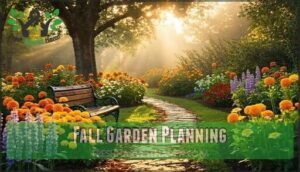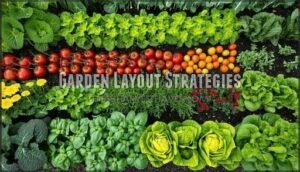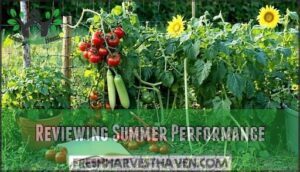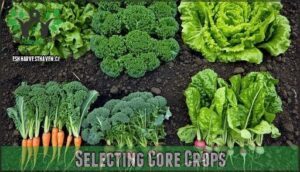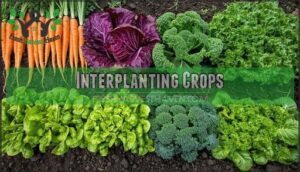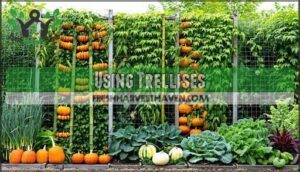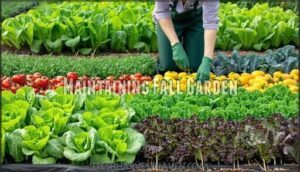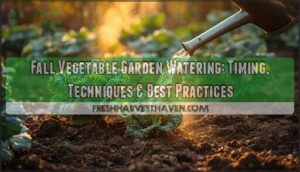This site is supported by our readers. We may earn a commission, at no cost to you, if you purchase through links.
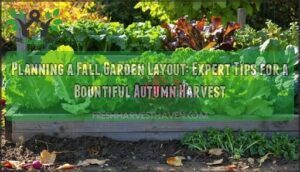 Planning a fall garden layout starts with knowing your first frost date and working backward to determine planting times.
Planning a fall garden layout starts with knowing your first frost date and working backward to determine planting times.
You’ll want to position cool-season crops like kale, spinach, and broccoli where they’ll get morning sun but afternoon protection.
Taller plants should go north to avoid shading shorter ones, and root vegetables like carrots and radishes fit nicely between larger plants.
Consider succession planting every two weeks for continuous harvests, and remember that raised beds warm up faster and drain better than ground plots.
Don’t forget about extending your season with row covers when temperatures drop, as smart spacing and timing transforms autumn disappointments into garden gold.
Table Of Contents
- Key Takeaways
- Fall Garden Planning
- Choosing Fall Vegetables
- Garden Layout Strategies
- Designing Garden Layout
- Maximizing Garden Space
- Preparing Garden Soil
- Maintaining Fall Garden
- Frequently Asked Questions (FAQs)
- How do I plant a fall garden?
- How do you make a good fall garden?
- What are the best Fall Garden ideas?
- How do you dress up a garden for fall?
- Is fall gardening right for your garden?
- How do you care for a fall garden?
- What month do you start a fall garden?
- Is there an app to plan a garden layout?
- What should you plant in your garden in the fall?
- How do you prepare the ground for a fall garden?
- Conclusion
Key Takeaways
- Know your first frost date and work backward – Check NOAA data or local extension offices to find your area’s average first frost, then count backward from that date using seed packet maturity times plus 1-2 weeks for slower fall growth.
- Position plants strategically for maximum sun exposure – Place taller crops like broccoli on the north side to prevent shading shorter plants, and give cool-season crops morning sun with afternoon protection as daylight hours decrease.
- Use succession planting for continuous harvests – Plant lettuce every 2 weeks, radishes every 10 days, and spinach every 2-3 weeks to ensure fresh vegetables from September through frost instead of one large harvest.
- Maximize space with raised beds and interplanting – Raised beds warm faster and drain better than ground plots, while interplanting fast-growing radishes between slower crops like carrots doubles your harvest from the same space.
Fall Garden Planning
You’ll need to plan your fall garden by checking the first frost date, counting backward for planting times, and considering how cooler weather affects growth rates.
Careful timing guarantees your crops mature before cold sets in, maximizing your autumn harvest.
Determining First Frost Date
Your first frost date serves as the cornerstone for fall garden planning.
Know your frost date—it’s your fall garden’s roadmap to success.
Check NOAA historical data or local extension offices to find your area’s average first frost date.
Regional variations span late September to early December across the U.S., with microclimates that can shift dates by two weeks, and urban areas typically experiencing later frosts than rural locations due to heat retention.
This information is crucial for planning, as understanding your area’s average first frost date and how regional variations impact it can help you prepare your garden accordingly.
Calculating Planting Times
Once you’ve pinpointed your first frost date, it’s time to set your planting schedule.
Use the Days to Maturity from your seed packets, then count backward from the Frost Date.
Add a Fall Factor—about one to two weeks—for slower growth.
Toss in a week for a staggered harvest and acclimation period.
Succession planting keeps your fall garden layout productive.
Considering Cooler Weather
Adjusting your garden plans for cooler weather becomes essential as autumn approaches.
Fall garden planning requires understanding frost tolerance and plant hardiness zones for cool season crops.
Create microclimates using cold protection techniques like row covers or cloches.
These seasonal changes mean shorter daylight hours slow growth, so your fall garden layout should maximize sun exposure while extending growing season through strategic frost protection placement.
Many gardeners find success with frost-tolerant varieties like kale and spinach.
Choosing Fall Vegetables
Selecting the right vegetables for your fall garden depends on understanding which plants thrive in cooler temperatures and shorter daylight hours.
You’ll want to focus on three main categories: cool season plants that actually prefer autumn conditions, warm season plants that can still produce before frost, and reliable root vegetables that sweeten as temperatures drop.
Cool Season Plants
Cool season crops form the backbone of your fall garden layout, thriving when temperatures drop below 70°F.
Cool season crops become autumn’s champions, delivering peak flavors when summer varieties fade.
These frost-tolerant vegetables actually improve in flavor as cold weather arrives. Kale, spinach, lettuce, and broccoli handle light frosts beautifully.
Your planting schedule should prioritize variety selection based on nutritional value and maturity rates. Cool season crops offer exceptional nutritional density.
They are a great choice because they can be planted at the right time to improve in flavor as the cold weather sets in.
Warm Season Plants
While cool season crops dominate fall gardens, warm season plants can thrive with proper garden planning.
Basil varieties, cucumber types, and pepper growing remain viable in regions with late frost dates. Sweet potato and eggplant care require 70-90 frost-free days, making timing critical.
Your vegetable garden layout should accommodate these heat-loving crops in the warmest spots. Container growing allows mobility for frost protection, extending your fall garden harvest window substantially.
Consider regional planting calendars for ideal yields.
Root Vegetables
Root vegetables transform from sturdy survivors into sweet treasures during fall planting.
These frost-tolerant champions thrive in cooler soil while developing enhanced flavors.
Your fall garden layout should include:
- Carrots – Plant 10-12 weeks before frost for maximum sweetness
- Beets – Harvest both nutritious greens and colorful roots
- Radishes – Quick 3-week maturity provides instant harvesting tips
Proper soil preparation guarantees successful companion planting with leafy greens.
Garden Layout Strategies
Your fall garden’s success depends on smart positioning and space management. Choose between raised beds, containers, or ground-level plots based on your available space and sunlight patterns.
Positioning Taller Plants
After picking your fall vegetables, think about where to place taller plants.
Set them on the north side of your garden layout to prevent sunlight obstruction for shorter crops.
This garden planning step helps with wind protection, boosts visual aesthetics, and supports companion planting.
Strategic positioning also creates microclimates, making your vegetable garden layout more productive and visually balanced for fall garden success.
Using Raised Beds
Raised garden beds transform your fall garden layout by elevating your vegetable garden above ground level.
These structures offer superior drainage benefits and soil warming properties that extend your growing season. Many gardeners find that pre-fabricated kits simplify construction.
- Soil warming: Elevated beds warm faster in cool fall weather, promoting better root development
- Drainage benefits: Prevents waterlogged soil during autumn’s heavy rains and morning dew
- Accessibility design: Reduces bending and makes harvesting easier during frequent fall maintenance
- Pest control: Creates barriers against ground-dwelling insects and improves air circulation
- Space optimization: Maximizes planting density while maintaining organized garden layout sections
Container Gardening
Container gardening offers flexibility for fall garden design when space is limited.
Choose containers with proper drainage holes and fill with quality potting mix. Consider container size for root development – larger vegetables need deeper pots.
Vertical containers maximize growing area while mobile gardens let you follow sunlight patterns. This approach works perfectly for herbs, lettuce, and compact vegetables in your fall garden layout.
Remember to account for the fall factor when planning your planting schedule.
Designing Garden Layout
Creating a successful fall garden starts with evaluating your summer garden’s performance to identify what worked well and what didn’t.
You’ll need to assess your space for sunlight patterns, water access, and changing shade conditions, then select 3-5 core crops that thrive in your area’s fall growing conditions, focusing on what will work well in your specific environment, considering the fall growing conditions.
Reviewing Summer Performance
Before diving into your fall garden layout, take stock of what worked and what didn’t in your summer garden.
This assessment reveals vital insights for designing a successful autumn vegetable garden layout.
- Crop successes: Note which plants thrived in specific locations and replicate those conditions
- Pest problems: Identify problem areas where insects concentrated and plan pest management strategies
- Space utilization: Evaluate crowded sections and watering issues to optimize your fall garden layout
Document soil depletion patterns where heavy feeders grew poorly.
This review forms the foundation for effective garden layout ideas that maximize your autumn harvest potential.
Assessing Sunlight and Water
After identifying what worked in your summer beds, you’ll need to map sunlight patterns and water access for fall garden design.
Observe how shadows shift as the sun’s angle changes, creating new microclimates in your space.
Check irrigation needs by testing soil moisture levels and hose reach. Shade assessment becomes critical since shorter days affect plant placement and watering strategies for ideal soil preparation.
Consider how reflective surfaces increase light in darker areas, which is crucial for ideal soil preparation and understanding the impact of shorter days.
Selecting Core Crops
After water and sunlight assessment, choosing the right vegetables becomes your garden’s foundation.
Smart crop selection balances quick wins with long-term harvests, ensuring your fall garden layout design delivers continuous food production.
Here are four core crop categories for ideal vegetable selection:
- Frost-tolerant varieties – Kale, Brussels sprouts, and carrots handle temperature drops gracefully
- Quick-growing options – Radishes and lettuce provide harvests in 30-45 days
- Dual-harvest crops – Beets offer both roots and greens for maximum yield
- Long-maturing choices – Broccoli needs early planting but rewards patience with dense heads
Focus on zone-specific crops that match your cool season planting schedule for reliable autumn success.
Maximizing Garden Space
Making the most of your fall garden space requires strategic planning that goes beyond simply planting in rows.
You can substantially increase your harvest by combining succession planting, interplanting techniques, and vertical growing methods that work together to maximize every square foot of your garden.
Succession Planting
Maximizing your fall garden layout means staggered planting becomes your secret weapon for continuous harvest.
Strategic crop rotation through planned planting windows guarantees fresh vegetables from September through frost. Smart seed starting schedules keep your vegetable garden layout productive all season long.
To optimize planting, consider using succession planting intervals for various crops.
| Crop | Planting Interval |
|---|---|
| Lettuce | Every 2 weeks |
| Radishes | Every 10 days |
| Spinach | Every 2-3 weeks |
| Carrots | Every 3 weeks |
| Bush Beans | Every 2-3 weeks |
Interplanting Crops
Smart gardeners know that companion planting transforms your fall vegetable garden layout into a productive ecosystem.
Interplanting crops maximizes space efficiency by combining fast-growing radishes with slower broccoli transplants.
This resource sharing strategy enhances pest control naturally while improving crop compatibility.
Your succession planting guide benefits from pairing leafy greens with root vegetables for ideal harvest timing.
Companion planting can also boost yields, with some studies showing a yield increase of 10-20%.
Using Trellises
Building on interplanting techniques, vertical growing transforms your fall garden layout into a three-dimensional masterpiece.
Trellises maximize space while providing essential plant support for climbing varieties.
Here are five trellis materials that deliver both function and aesthetic appeal:
- Bamboo poles – lightweight, affordable, and naturally weather-resistant for peas and beans
- Wire cattle panels – sturdy steel mesh perfect for heavy vining crops like winter squash
- Wooden A-frames – classic garden structures that support multiple climbing plants simultaneously
- Metal obelisks – decorative tower designs that add vertical interest while supporting delicate climbers
- String trellises – simple twine systems stretched between posts for lightweight fall vegetables
These space saving solutions help you grow more food in less area while creating attractive garden focal points.
For sourcing, consider options for durable garden supports.
Preparing Garden Soil
Healthy soil forms the foundation of any productive fall garden, requiring attention to organic matter and nutrient availability before planting begins.
You’ll need to assess current soil conditions and implement strategies like cover cropping and mulching to create ideal growing conditions for your autumn vegetables.
Soil Health Strategies
Healthy soil serves as your garden’s foundation, directly impacting plant growth and harvest quality.
Focus on composting methods that increase organic matter while supporting beneficial soil microbes. Regular soil amendments improve nutrient cycling and water retention, creating favorable growing conditions.
| Strategy | Benefit |
|---|---|
| Add compost regularly | Improves soil structure and nutrient cycling |
| Test pH levels annually | Guarantees proper nutrient availability |
| Apply organic mulch | Enhances water retention and erosion control |
| Reduce soil compaction | Promotes healthy soil microbes and root growth |
Incorporating Cover Crops
Cover crops transform your fall garden into a soil-building powerhouse.
Winter rye and crimson clover provide exceptional Erosion Control while adding valuable organic matter.
These green allies excel at Nitrogen Fixation, with legumes contributing up to 200 pounds per acre.
Plant cover crops 4-6 weeks before frost for ideal establishment.
They’ll suppress weeds naturally and support Biodiversity Support through enhanced soil health and beneficial insect habitat.
Mulching Techniques
Proper mulching transforms your fall garden maintenance routine into a strategic advantage.
Apply these techniques to maximize your autumn harvest:
- Organic Mulches: Use straw, shredded leaves, or compost around plants for soil enrichment
- Inorganic Mulches: Consider landscape fabric or gravel for permanent pathways in garden layout planning
- Mulch Depth: Maintain 2-3 inches around plants, avoiding direct stem contact
- Mulch Timing: Apply after soil warms but before peak growing season
- Weed Control: Create barrier zones between crop rows for effective fall garden design.
You can find various options for garden soil enrichment.
Maintaining Fall Garden
Once you’ve established your fall garden layout, maintaining it properly guarantees healthy crops and maximum yields throughout the season.
You’ll need to monitor plant health, protect against pests and diseases, and use techniques to extend your harvest as temperatures drop, which is crucial for achieving maximum yields.
Caring for Fall Crops
Your fall crops need consistent care to reach their full potential.
Watering strategies should adjust to cooler temperatures – you’ll need less frequent but deeper watering as evaporation rates drop.
Fertilizing schedule becomes lighter since nitrogen-heavy feeds can make plants vulnerable to frost.
Weed control stays important as weeds compete for nutrients during slower growth periods.
Harvesting tips include picking outer leaves first on greens, allowing centers to continue growing for extended harvests.
Managing Pests and Diseases
Once you’ve got your fall crops thriving, it’s time to focus on pest management and disease prevention.
Regular checks help you spot fall garden pests early.
Use organic pest control like soapy water sprays, encourage beneficial insects, and practice crop rotation.
Remove plant debris, try companion planting, and keep air flowing for healthy plants.
These steps boost garden health and pest reduction.
Extending Harvest Season
Beyond traditional growing methods, you can stretch your fall garden’s productivity with strategic techniques.
Succession sowing every two weeks creates staggered planting schedules for continuous harvests.
Key approaches include:
- Frost protection using row covers extends overwintering crops through cold snaps
- Multiple harvests from cut-and-come-again varieties like lettuce and spinach
- Extended harvest timing by selecting varieties with different maturity dates
This planting guide fall approach maximizes your fall vegetable garden’s potential.
Frequently Asked Questions (FAQs)
How do I plant a fall garden?
Start by checking your first frost date, then count backward to schedule planting.
Choose cool-season crops like kale, carrots, and broccoli.
Place taller plants north, use raised beds for space, and stagger sowing for continuous harvests.
How do you make a good fall garden?
Choose frost-tolerant crops like kale, broccoli, and carrots. Time plantings by counting backward from your first frost date. Plant tall crops north, short ones south for ideal sunlight.
What are the best Fall Garden ideas?
Crisp autumn air signals nature’s second chance at gardening glory.
You’ll maximize harvests by planting frost-tolerant crops like kale, broccoli, and carrots that actually sweeten in cooler temperatures.
While succession planting guarantees continuous fresh produce.
How do you dress up a garden for fall?
Add pops of color with pansies, ornamental kale, and salvias.
Tuck in fall veggies like kale and Swiss chard for texture.
Use mulch for tidy beds, and set stepping stones to keep your feet dry on dewy mornings.
Is fall gardening right for your garden?
Fall gardening acts like a garden’s second wind, offering cooler temperatures, fewer pests, and sweeter flavors.
You’ll enjoy extended harvests from summer crops while growing cold-hardy vegetables like kale and broccoli that actually thrive in autumn’s embrace.
How do you care for a fall garden?
Keep your fall garden thriving by watering consistently, watching for early frost, and mulching to insulate roots.
Pull weeds, check for pests, and harvest regularly—think of it as giving your plants a cozy autumn sweater.
What month do you start a fall garden?
While others chase summer’s last gasps, you’re plotting autumn’s victory by starting your fall garden in late July or August, working backward from your first frost date.
Is there an app to plan a garden layout?
Several popular garden planning apps can help you design your layout.
Planter Garden Planner offers companion planting information and square foot gardening grids, while Garden Manager lets you create beds visually.
What should you plant in your garden in the fall?
Strike while the iron is hot" applies perfectly to fall planting.
You’ll want to sow cool-season crops like kale, lettuce, spinach, broccoli, carrots, and radishes that thrive in cooler temperatures and fewer pests.
How do you prepare the ground for a fall garden?
Clear debris, weeds, and old plants from beds. Test soil pH and amend with compost. Till or loosen compacted soil to 6-8 inches deep for proper root development.
Conclusion
Like a master chef preparing ingredients before the main course, planning a fall garden layout sets the foundation for your autumn harvest success.
You’ve learned that positioning cool-season crops strategically, calculating planting times from your first frost date, and maximizing space through succession planting creates garden efficiency.
Your raised beds, proper plant spacing, and season-extending techniques will transform your fall garden from ordinary to extraordinary.
With these proven strategies for planning a fall garden layout, you’ll enjoy fresh vegetables well into winter.
- https://joegardener.com/podcast/what-to-plant-now-fall-vegetable-garden/
- https://www.thepurposefulyou.com/blog/growing-a-fall-garden-a-sample-plan
- https://awaytogarden.com/what-to-plant-now-for-a-fall-vegetable-garden/
- https://www.reddit.com/r/vegetablegardening/comments/14j26o7/ideas_for_a_fall_garden/
- https://shiplapandshells.com/transition-garden-from-summer-to-fall/

